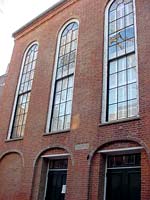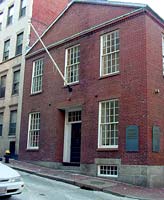African Meeting House/Abiel Smith School
African Meeting House | ||
 | The oldest black church edifice still standing in the United States, the African Meeting House's origins lie in the fact that churches were segregated in Boston. African Americans could not be voting members of churches and were only allowed to sit in the balconies. An African-American preacher, Thomas Paul, started a black congregation that bought land for a church in the West End. Cato Gardner, who was born in Africa, raised enough money to inspire the congregation to dedicate a plaque in his honor. It reads "Cato Gardner, first Promoter of this Building 1806" and is still above the entranceway. The Meeting House was completed in 1806. At the dedication ceremony African Americans sat in the balcony and whites sat in the pews. By the late 1800s, African Americans were living primarily in the South End and Roxbury. At that time the African Meeting House was sold to a Jewish congregation. The Museum of Afro American History bought the building in 1972. Located at 8 Smith Court. | |
Abiel Smith School | ||
| Until the 1834 construction of the Abiel Smith School, the school for African-American children was housed in the African Meeting House. Smith, a white businessman, donated $2,000 to the city of Boston to help educate African-American children. As early as 1787, the African-American community in Boston petitioned the state legislature to give black children access to public schools. Their requests were denied. The community started a school in the home of Prince Hall, which moved to the African Meeting House in 1808. The city opened schools for African Americans in the 1820s, and the state legislature passed an anti-segregation bill in 1855. The school closed at that time and was used to store furniture; it was then used as a headquarters for black Civil War veterans. The school was fully renovated in 2000 and is now part of the Museum of Afro American History. Located at 46 Joy Street. |  | |
| Previous | Boston Field Trip: Home | Next --> |





